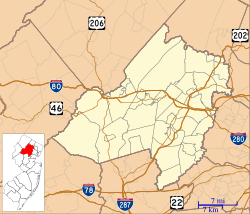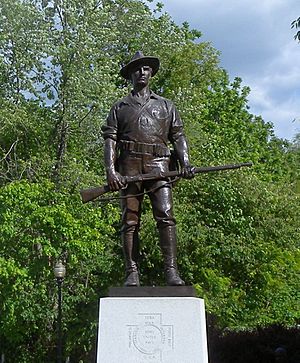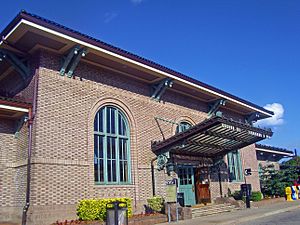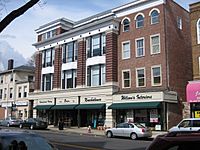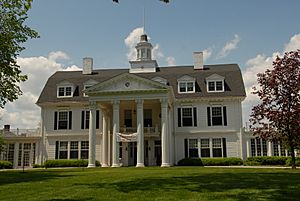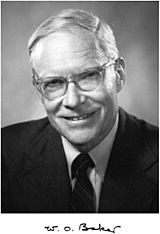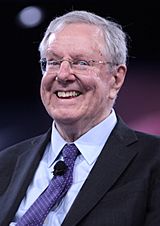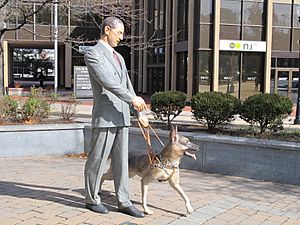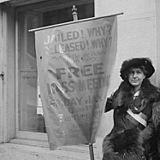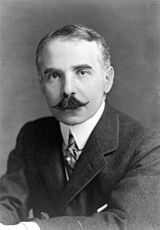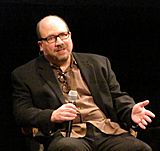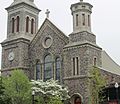Morristown, New Jersey facts for kids
Quick facts for kids
Morristown, New Jersey
|
|
|---|---|
|
Town
|
|
| Town of Morristown | |
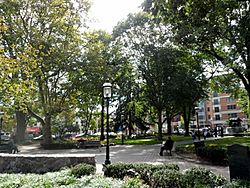
The Green, a historic park, serves as a gathering place and a center of culture within Downtown Morristown.
|
|
| Nickname(s):
"Military Capital of the American Revolution", "Mo Town", "The Mo", "Mo City"
|
|
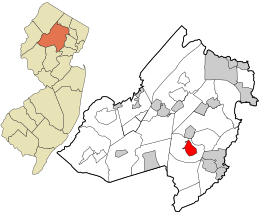
Location in Morris County and the state of New Jersey
|
|
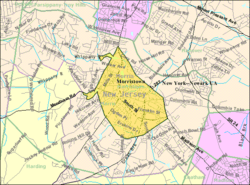
Census Bureau map of Morristown, New Jersey
|
|
| Country | |
| State | |
| County | |
| Founded | 1715 |
| Incorporated | April 6, 1865 |
| Government | |
| • Type | Faulkner Act (mayor–council) |
| • Body | Town Council |
| Area | |
| • Total | 3.01 sq mi (7.79 km2) |
| • Land | 2.91 sq mi (7.53 km2) |
| • Water | 0.10 sq mi (0.25 km2) 3.26% |
| Area rank | 333rd of 565 in state 25th of 39 in county |
| Elevation | 315 ft (96 m) |
| Population | |
| • Total | 18,411 |
| • Estimate
(2019)
|
19,261 |
| • Rank | 139th of 566 in state 10th of 39 in county |
| • Density | 6,284.9/sq mi (2,426.6/km2) |
| • Density rank | 78th of 566 in state 3rd of 39 in county |
| Time zone | UTC−05:00 (Eastern (EST)) |
| • Summer (DST) | UTC−04:00 (Eastern (EDT)) |
| ZIP Codes |
07960-07963
|
| Area code(s) | 862/973 |
| FIPS code | 3402748300 |
| GNIS feature ID | 0885309 |
Morristown is a town and the county seat of Morris County, New Jersey, United States. Morristown has been called "the military capital of the American Revolution" because of its strategic role in the war for independence from Great Britain. Today this history is visible in a variety of locations throughout the town that collectively make up Morristown National Historical Park.
According to British colonial records, the first permanent European settlement at Morristown occurred in 1715, when a settlement was founded as New Hanover by colonists from New York and Connecticut. Morris County was created on March 15, 1739, from portions of Hunterdon County. The county, and ultimately Morristown itself, was named for the popular Governor of the Province, Lewis Morris, who championed land ownership rights for colonists.
Morristown was incorporated as a town by an act of the New Jersey Legislature on April 6, 1865, within Morris Township, and it was formally set off from the township in 1895. As of the 2010 United States Census, the town's population was 18,411, reflecting a decline of 133 (-0.7%) from the 18,544 counted in the 2000 Census, which had in turn increased by 2,355 (+14.5%) from the 16,189 counted in the 1990 Census.
Contents
History
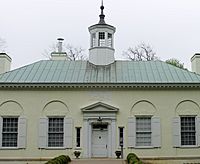
The area was inhabited by the Lenni Lenape Native Americans for up to 6,000 years prior to exploration by Europeans. The first European settlements in this portion of New Jersey were established by the Swedes and Dutch in the early 17th century, when a significant trade in furs existed between the natives and the Europeans at temporary posts. It became part of the Dutch colony of New Netherland, but the English seized control of the region in 1664, which was granted to Sir George Carteret and John Berkeley, 1st Baron Berkeley of Stratton, as the Province of New Jersey.
Eighteenth century
Morristown was settled around 1715 by English Presbyterians from Southold, New York on Long Island and New Haven, Connecticut as the village of New Hanover. The town's central location and road connections led to its selection as the seat of the new Morris County shortly after its separation from Hunterdon County on March 15, 1739. The village and county were named for Lewis Morris, the first and then sitting royal governor of a united colony of New Jersey.
By the middle of the 18th century, Morristown had 250 residents, with two churches, a courthouse, two taverns, two schools, several stores, and numerous mills and farms nearby.
George Washington first came to Morristown in May 1773, two years before the Revolutionary War broke out, and traveled from there to New York City together with John Parke Custis (his stepson) and Lord Stirling.
In 1777, General George Washington and the Continental Army marched from the victories at Trenton and Princeton to encamp near Morristown from January to May. Washington had his headquarters during that first encampment at Jacob Arnold's Tavern located at the Morristown Green in the center of the town. Morristown was selected for its extremely strategic location. It was between Philadelphia and New York and near New England. It also was chosen for the skills and trades of the residents, local industries and natural resources to provide arms, and what was thought to be the ability of the community to provide enough food to support the army.
The churches were used for inoculations for smallpox. That first headquarters, Arnold's Tavern, was eventually moved .5 miles (800 m) south of the green onto Mount Kemble Avenue to become All Souls Hospital in the late 19th century. It suffered a fire in 1918, and the original structure was demolished, but new buildings for the hospital were built directly across the street.
From December 1779 to June 1780 the Continental Army's second encampment at Morristown was at Jockey Hollow. Then, Washington's headquarters in Morristown was located at the Ford Mansion, a large mansion near what was then the 'edge of town.' Ford's widow and children shared the house with Martha Washington and officers of the Continental Army. "
The winter of 1780 was the worst winter of the Revolutionary War. The starvation was complicated by extreme inflation of money and lack of pay for the army. The entire Pennsylvania contingent successfully mutinied and later, 200 New Jersey soldiers attempted to emulate them (unsuccessfully).
During Washington's second stay, in March 1780, he declared St. Patrick's Day a holiday to honor his many Irish troops. Martha Washington traveled from Virginia and remained with her husband each winter throughout the war. The Marquis de Lafayette came to Washington in Morristown to inform him that France would be sending ships and trained soldiers to aid the Continental Army.
The Ford Mansion, Jockey Hollow, and Fort Nonsense are all preserved as part of Morristown National Historical Park managed by the National Park Service, which has the distinction among historic preservationists of being the first National Historical Park established in the United States.
During Washington's stay, Benedict Arnold was court-martialed at Dickerson's Tavern, on Spring Street, for charges related to profiteering from military supplies at Philadelphia. His admonishment was made public, but Washington quietly promised the hero, Arnold, to make it up to him.
Alexander Hamilton courted and wed Elizabeth Schuyler at a residence where Washington's personal physician was billeted. Locally known as the Schuyler-Hamilton House, the Dr. Jabez Campfield House is listed on both the New Jersey and National Register of Historic Places.
The Morristown Green has a statue commemorating the meeting of George Washington, the young Marquis de LaFayette, and young Alexander Hamilton depicting them discussing forthcoming aid of French tall ships and troops being sent by King Louis XVI of France to aid the Continental Army.
Morristown's Burnham Park has a statue of the "Father of the American Revolution", Thomas Paine, who wrote the best selling booklet Common Sense, which urged a complete break from British rule. The bronze statue, by sculptor Georg J. Lober, shows Paine in 1776 (using a drum as a table during the withdrawal of the army across New Jersey) composing Crisis 1. He wrote These are the times that try men's souls .... The statue was dedicated on July 4, 1950.
Nineteenth century to present
The idea for constructing the Morris Canal is credited to Morristown businessman George P. Macculloch, who in 1822 convened a group to discuss his concept for a canal. The group included Governor of New Jersey Isaac Halstead Williamson, which led to approval of the proposal by the New Jersey Legislature later that year. The canal was used for a century. In July 1825 during his 15 month return tour of the United States, the Marquis de Lafayette returned to Morristown, where a ball was held in his honor at the 1807 Sansay House on DeHart Street (the edifice still stands as of 2011).
Antoine le Blanc, a French immigrant laborer murdered the Sayre family and their servant (or possibly slave), Phoebe. He was tried and convicted of murder of the Sayres (but not of Phoebe) on August 13, 1833. On September 6, 1833, Le Blanc became the last person hanged on the Morristown Green. Until late 2006, the house where the murders were committed was known as "Jimmy's Haunt," which is purported to be haunted by Phoebe's ghost because her murder never saw justice. In 2007 Jimmy's Haunt was torn down to make way for a bank.
Samuel F. B. Morse and Alfred Vail built the first telegraph at the Speedwell Ironworks in Morristown on January 6, 1838. The first telegraph message was A patient waiter is no loser. The first public demonstration of the invention occurred five days later as an early step toward the information age.
Jacob Arnold's Tavern, the first headquarters for Washington in Morristown, was purchased by the Colles family to save it from demolition in 1886. It was moved by horse-power in the winter of 1887 from "the green" (after being stuck on Bank Street for about six weeks) to a site 0.5 miles (0.80 km) south on Mount Kemble Avenue at what is now a parking lot for the Atlantic RIMM Rehabilitation Hospital. It became a boarding house for four years until it was converted by the Grey Nuns from Montreal into All Souls Hospital, the first general hospital in Morris County. George and Martha Washington's second floor ballroom became a chapel and the first floor tavern became a ward for patients. The building was lost to a fire in 1918. The entire organization, nurses, doctors, and patients of All Souls Hospital were then moved across Mount Kemble Avenue, U.S. Route 202, to a newly built brick hospital building. All Souls' was set to close because of financial difficulties in the late 1960s. In 1973, it became Community Medical Center. In 1977, the center became bankrupt and was purchased by the then new and larger Morristown Memorial Hospital, which is now the Morristown Medical Center.
On December 18, 1843, the Bethel African Methodist Episcopal Church was incorporated. This was the first congregation established by blacks in Morris County. It is still active. The first site of the Church was located at 13 Spring Street and served as the only schoolhouse for colored children until 1870. The Church relocated to its present site at 59 Spring Street in 1874.
On January 5, 2009, five red lights were spotted in the Morristown area night skies. The event was a staged hoax using helium balloons and flares, but became nationally known as the Morristown UFO hoax.
Geography
According to the United States Census Bureau, Morristown had a total area of 3.026 square miles (7.839 km2), including 2.929 square miles (7.587 km2) of land and 0.097 square miles (0.252 km2) of water (3.22%).
Morristown is completely surrounded by Morris Township, making it part of 21 pairs of "doughnut towns" in the state, where one municipality entirely surrounds another.
The downtown shopping and business district of Morristown is centered around a square park, known as the Morristown Green. It is a former market square from Morristown's colonial days.
Climate
Morristown has a humid continental climate (Köppen climate classification Dfa/Dfb).
| Climate data for Morristown | |||||||||||||
|---|---|---|---|---|---|---|---|---|---|---|---|---|---|
| Month | Jan | Feb | Mar | Apr | May | Jun | Jul | Aug | Sep | Oct | Nov | Dec | Year |
| Average high °F (°C) | 38 (3) |
41 (5) |
50 (10) |
61 (16) |
71 (22) |
80 (27) |
85 (29) |
83 (28) |
75 (24) |
65 (18) |
54 (12) |
43 (6) |
62 (17) |
| Average low °F (°C) | 18 (−8) |
19 (−7) |
27 (−3) |
36 (2) |
46 (8) |
54 (12) |
59 (15) |
58 (14) |
51 (11) |
39 (4) |
32 (0) |
23 (−5) |
39 (4) |
| Average precipitation inches (mm) | 4.50 (114) |
3.00 (76) |
4.41 (112) |
4.64 (118) |
5.09 (129) |
4.40 (112) |
5.29 (134) |
4.37 (111) |
5.33 (135) |
4.17 (106) |
4.37 (111) |
4.10 (104) |
53.67 (1,363) |
Demographics
| Historical population | |||
|---|---|---|---|
| Census | Pop. | %± | |
| 1880 | 5,418 | — | |
| 1890 | 8,156 | 50.5% | |
| 1900 | 11,267 | 38.1% | |
| 1910 | 12,507 | 11.0% | |
| 1920 | 12,548 | 0.3% | |
| 1930 | 15,197 | 21.1% | |
| 1940 | 15,270 | 0.5% | |
| 1950 | 17,124 | 12.1% | |
| 1960 | 17,712 | 3.4% | |
| 1970 | 17,662 | −0.3% | |
| 1980 | 16,614 | −5.9% | |
| 1990 | 16,189 | −2.6% | |
| 2000 | 18,544 | 14.5% | |
| 2010 | 18,411 | −0.7% | |
| 2019 (est.) | 19,261 | 4.6% | |
| Population sources: 1880-1920 1880-1890 1890-1910 1880-1930 1930-1990 2000 2010 |
|||
2010 Census
As of the census of 2010, there were 18,411 people, 7,417 households, and 3,649 families residing in the town. The population density was 6,284.9 per square mile (2,426.6/km2). There were 8,172 housing units at an average density of 2,789.6 per square mile (1,077.1/km2)*. The racial makeup of the town was 62.50% (11,507) White, 13.97% (2,572) Black or African American, 0.64% (117) Native American, 4.34% (799) Asian, 0.06% (11) Pacific Islander, 14.84% (2,732) from other races, and 3.66% (673) from two or more races. [[Hispanic (U.S. Census)|Hispanic or Latino of any race were 34.09% (6,277) of the population.
There were 7,417 households out of which 22.7% had children under the age of 18 living with them, 31.1% were married couples living together, 12.0% had a female householder with no husband present, and 50.8% were non-families. 38.8% of all households were made up of individuals, and 9.5% had someone living alone who was 65 years of age or older. The average household size was 2.40 and the average family size was 3.13.
In the town, the population was spread out with 17.6% under the age of 18, 9.7% from 18 to 24, 38.4% from 25 to 44, 22.9% from 45 to 64, and 11.5% who were 65 years of age or older. The median age was 34.8 years. For every 100 females there were 104.5 males. For every 100 females ages 18 and old there were 106.1 males.
The Census Bureau's 2006-2010 American Community Survey showed that (in 2010 inflation-adjusted dollars) median household income was $64,279 (with a margin of error of +/- $5,628) and the median family income was $66,070 (+/- $3,638). Males had a median income of $51,242 (+/- $6,106) versus $44,315 (+/- $5,443) for females. The per capita income for the borough was $37,573 (+/- $2,286). About 10.2% of families and 9.5% of the population were below the poverty line, including 16.1% of those under age 18 and 8.8% of those age 65 or over.
Arts and culture
Morristown is home to the Morris Museum, formally incorporated in 1943. The museum's permanent displays include rocks, minerals, fossils, animal mounts, a model railroad, and Native American crafts, pottery, carving, basketry and textiles.
The Mayo Performing Arts Center, is a former Walter Reade movie theater originally constructed in 1937 that has been converted into a 1,302-seat performing arts center.
Transportation
Roads and highways
As of May 2010[update], the town had a total of 39.98 miles (64.34 km) of roadways, of which 29.73 miles (47.85 km) were maintained by the municipality, 5.03 miles (8.10 km) by Morris County and 5.22 miles (8.40 km) by the New Jersey Department of Transportation.
Interstate 287 is the main highway providing access to Morristown. Two interchanges, Exit 35 and Exit 36, are located within the town. Other significant roads serving Morristown include U.S. Route 202, New Jersey Route 124 and County Route 510.
Newark Liberty International Airport in Newark / Elizabeth is approximately 20 minutes away via Route 24 to Interstate 78.
Public transportation
Morristown has attempted to implement transit-oriented development. Morristown was designated in 1999 as of one of New Jersey's first five "transit villages". In 1999, Morristown changed its zoning code to designate the area around the train station as a "Transit Village Core" for mixed-use. The designation was at least partly responsible for development plans for several mixed-use condominium developments.
NJ Transit offers rail service at the Morristown station which offers service on the Morristown Line to Newark Broad Street, Secaucus Junction, New York Penn Station and Hoboken Terminal. The town benefited from shortened commuting times to New York City due to the "Midtown Direct" service New Jersey Transit instituted in the 1990s.
NJ Transit local bus service is offered from the Morristown rail station, Morristown Medical Center and Headquarters Plaza on the 871, 872, 873, 874, 875 and 880 bus routes, replacing service that had been offered on the MCM1, MCM2, MCM3, MCM4, MCM8 and MCM10 routes until 2010, when subsidies to the local provider were eliminated as part of budget cuts.
Community Coach provides daily service between New York City and Morristown on bus route 77.
The town's Department of Public Works operates "Colonial Coach", which provides free transportation within Morristown.
The Whippany Line of the Morristown and Erie Railway, a small freight line, traverses the township. Established in 1895, the line runs from Morristown and runs through East Hanover Township and Hanover Township to Roseland.
Statues
- One of only two heroic statues of Thomas Paine in the United States is located in Morristown; the other is found in Bordentown.
- One of the few statues depicting an unblindfolded Lady Justice adorns the facade of the Courthouse.
Economy
Companies based in Morristown include Capsugel, Covanta Energy, Louis Berger Group, Schindler Group and the Morristown & Erie Railway , a local short-line freight railway and Honeywell.
Morristown Medical Center, with 5,500 employees, is Morristown's largest employer. In a ruling issued in June 2015, Tax Court Judge Vito Bianco ruled that the hospital would be required to pay property taxes on nearly all of its campus in the town.
Education
The Morris School District is a regional public school district that serves students in pre-kindergarten through twelfth grade from the communities of Morristown and Morris Township, and high school students (grades 9-12) from Morris Plains who attend the high school as part of a sending/receiving relationship with the Morris Plains Schools. As of the 2018–19 school year, the district, comprised of 10 schools, had an enrollment of 5,216 students and 441.4 classroom teachers (on an FTE basis), for a student–teacher ratio of 11.8:1. Schools in the district (with 2018–19 enrollment data from the National Center for Education Statistics) are Lafayette Learning Center (102 students; in grade PreK), Alexander Hamilton School (293; 3–5), Hillcrest School (288; K-2), Thomas Jefferson School (314; 3–5), Normandy Park School (302; K-5), Sussex Avenue School (301; 3–5), Alfred Vail School (297; K-2), Woodland School (289; K-2), Frelinghuysen Middle School (1,081; 6–8) and Morristown High School (1,860; 9-12). The nine elected seats on the board of education are allocated based on the population of the constituent municipalities, with four seats assigned to Morristown.
In addition to a public school system, Morristown has several private schools. Primary and elementary schools include The Red Oaks School, an independent private school founded in 1965 and serving pre-kindergarten through eighth grade, that offers both Montessori and International Baccalaureate programs. Assumption Roman Catholic is a grade school (K-8) that operates under the auspices of the Roman Catholic Diocese of Paterson and was one of 11 schools in the state recognized in 2014 by the United States Department of Education's National Blue Ribbon Schools Program. The Peck School, a private day school which serves approximately 300 students in kindergarten through grade eight, dates back to 1893 when it was originally established as Miss Sutphen's School. The Delbarton School is an all-boys Roman Catholic school with approximately 540 students in grades seven through twelve, that began serving resident students in 1939 after having previously served as a seminary. The Morristown-Beard School, a private co-ed school formed from the merger of two previously existing institutions, Morristown Preparatory School and Miss Beard's School, serves grades 6 through 12. In addition, Villa Walsh Academy, a private Catholic college preparatory school conducted by the Religious Teachers Filippini, is located in Morristown.
The Academy of Saint Elizabeth was founded at Morristown in 1860 by the Sisters of Charity, however when municipal boundaries were redrawn in 1895, the Academy found itself in the Convent Station section of the adjacent Morris Township.
The Rabbinical College of America, one of the largest Chabad Lubavitch Chasidic yeshivas in the world is located in Morristown. The Rabbinical College of America has a Baal Teshuva yeshiva for students of diverse Jewish backgrounds, named Yeshiva Tiferes Bachurim. The New Jersey Regional Headquarters for the worldwide Chabad Lubavitch movement is located on the campus.
Notable people
People who were born in, residents of, or otherwise closely associated with Morristown include:
- Frank D. Abell (1878-1964), politician who served in the New Jersey General Assembly in 1925 and 1926 and the New Jersey Senate from 1926 to 1931
- Kenny Agostino (born 1992), professional ice hockey player for the New Jersey Devils of the National Hockey League
- Joseph Bushnell Ames (1878-1928), novelist
- Kristina Apgar (born 1985), actress best known for her portrayal of Lily Smith on the CW's drama Privileged
- Michael Ashkin (born 1955), artist known for sculptures, videos, photographs and installations depicting marginalized, desolate landscapes
- William O. Baker (1915–2005), scientist who headed Bell Labs
- James Berardinelli (born 1967), film critic
- Vincenzo Bernardo (born 1990), professional soccer player
- Faire Binney (1900–1957), stage and film actress who starred in films during the silent era after making her debut in the 1918 film Sporting Life alongside her sister Constance Binney.
- Anna Campbell Bliss (1925-2015), visual artist and architect
- Scott Blumstein (born 1992), poker player who won the 2017 World Series of Poker Main Event for $8,150,000
- Warren Bobrow (born c. 1961), mixologist, chef, and writer known as the "Cocktail Whisperer"
- Rinker Buck (born 1950), author best known for his 1997 memoir Flight of Passage
- Tez Cadey (born 1993), French-American DJ, record producer and songwriter
- Jabez Campfield (1737–1821), doctor who served as a surgeon in the Continental Army during the American Revolutionary War.
- Lincoln Child (born 1957), author of techno-thriller and horror novels
- George T. Cobb (1813–1870), represented New Jersey's 4th congressional district from 1861 to 1863, and Mayor of Morristown from 1865 to 1869
- Lewis Condict (1772–1862), physician and member of the United States House of Representatives from New Jersey
- Silas Condict (1738–1801), farmer, surveyor and landowner, who served as a delegate to the Continental Congress from New Jersey
- Donald Cresitello, Mayor of Morristown from 2006 to 2010
- Augustus W. Cutler (1827–1897), member of the United States House of Representatives from New Jersey
- Jean Dalrymple (1902-1998), theater producer, manager, publicist and playwright, who was instrumental in the founding of New York City Center
- Joe Dante (born 1946), film director
- Alex DeCroce (1936-2012), politician who served in the New Jersey General Assembly, where he represented the 26th Legislative District from 1989 until his death
- Peter Dinklage (born 1969), Emmy Award-winning actor
- Dorothy Harrison Eustis (1886-1946) - dog breeder, philanthropist, founder of The Seeing Eye guide dog school.
- Caroline C. Fillmore (1813–1881), wife of President Millard Fillmore; born in Morristown
- Nic Fink (born 1993), Olympic swimmer who specializes in breaststroke events
- Chris Fletcher (born 1948), former safety, played in the NFL for the San Diego Chargers, 1970-1976
- Steve Forbes (born 1947), editor-in-chief of Forbes and two-time Republican candidate for President of the United States
- Caroline Rose Foster (1877–1979), farmer and founder of Fosterfields, a working historical farm
- Adam Gardner (born 1973), singer, songwriter, and guitarist of the band Guster; grew up in Morristown
- Samuel Hazard Gillespie Jr. (1910–2011), former U.S. Attorney for the Southern District of New York
- Justin Gimelstob (born 1977), professional tennis player
- Anna Harrison (1775–1864), First Lady of the United States, wife of President William Henry Harrison and grandmother of President Benjamin Harrison
- Tobin Heath (born 1988), United States national soccer team player and member of the female professional team Portland Thorns FC
- Markus Howard (born 1999), player for the Marquette Golden Eagles men's basketball team
- Linda Hunt (born 1945), Academy Award-winning actress
- Julia Hurlbut (1882–1962), suffragist who served as the vice chairman of the New Jersey branch of the National Woman's Party
- I. Stanford Jolley (1900–1978), film and television actor who starred in the 1946 serial film The Crimson Ghost.
- Otto Hermann Kahn (1867–1934), German-born banker, investor, philanthropist and Rutgers University trustee maintained a home in Morristown
- Roger Wolfe Kahn (1907–1962), bandleader, composer, nightclub owner, aviator; Otto Kahn's son; born in Morristown
- Nolan Kasper (born 1989), World Cup alpine ski racer who competes in the technical events and specializes in the slalom
- Anthony W. Knapp (born 1941), mathematician at the Stony Brook University working on representation theory who classified the tempered representations of a semisimple Lie group
- Ted Koffman (born 1944), politician who served in the Maine House of Representatives from 2000 to 2008
- Luther Kountze (1841–1918), banker who built an estate in Morristown in the late 1880s
- Connor Lade (born 1989), soccer player for New York Red Bulls
- Fran Lebowitz (born 1950), author, columnist and actor
- David Hunter McAlpin (1816–1901), prominent industrialist and real estate owner in New York City
- Dave Moore (born 1969), former NFL tight end
- Troy Murphy (born 1980), professional basketball player
- Thomas Nast (1840–1902), caricaturist and editorial cartoonist; lived in Morristown for more than 20 years
- Craig Newmark (born 1952), founder of Craigslist; born in Morristown and attended Morristown High School
- Neil O'Donnell (born 1966), former NFL quarterback, most notably for the Pittsburgh Steelers
- John Panelli (1926–2012), football player who played in the NFL for the Detroit Lions and the Chicago Cardinals
- Sister Parish (1910–1994), interior decorator and socialite, most notably as the first interior designer brought in to decorate the Kennedy White House
- Doug Payne (born 1981, class of 2000), American equestrian who was selected to compete for the United States in the delayed 2020 Summer Games in Tokyo.
- Mahlon Pitney (1858–1924), Associate Justice of the United States Supreme Court
- Johanna Poethig (born 1956), Bay Area visual, public and performance artist
- Debra Ponzek, chef, owner of Aux Délices restaurants in Connecticut
- Rick Porcello (born 1988), starting pitcher for the Boston Red Sox
- Andrew Prendeville (born 1981), professional automobile racer
- Sarah Price (born 1969), author
- Dan Quinn (born 1970), football defensive coordinator for the Super Bowl XLVIII champion Seattle Seahawks, former head coach of the Atlanta Falcons in Super Bowl LI and current defensive coordinator for the Dallas Cowboys
- Robert Randolph, guitarist, of Robert Randolph & the Family Band
- Rocky Rees (born 1949), head football coach at Shippensburg University of Pennsylvania, 1990-2010
- Garrett Reisman (born 1968), NASA astronaut, first American to be on board the International Space Station
- Rick Rescorla (1939–2001), head of Morgan Stanley World Trade Center security during the September 11 terrorist attacks
- Jordan Riak (1935–2016), activist against corporal punishment
- William P. Richardson (1864–1945), co-founder and first Dean of Brooklyn Law School
- Tony Scott (1921–2007), bebop clarinetist, arranger, New World music innovator
- Gene Shalit (born 1932), film critic on NBC's The Today Show
- Alexander Slobodyanik (1941–2008), classical pianist
- Leila Clement Spaulding (1878–1973), classicist and archaeologist
- John Cleves Symmes (1742–1814), delegate to the Continental Congress; pioneer responsible for the Symmes Purchase; father-in-law of President William Henry Harrison
- Kathryn Tappen (born 1981), sportscaster who works on NBC Sports Group's coverage of hockey and football
- Jahmar Thorpe (born 1984), professional basketball player for the Iwate Big Bulls in Japan
- Jyles Tucker (born 1983), linebacker for the San Diego Chargers
- Bayard Tuckerman Jr. (1889–1974), jockey, businessman and politician
- Alfred Vail (1807–1859), inventor of Morse code
- Frederick T. van Beuren Jr. (1876-1943), appointed president of Morristown Memorial Hospital in 1933
- Tom Verlaine (born 1949), songwriter, guitarist, and lead singer for the New York rock band Television
- Daniel Spader Voorhees (1852–1935), New Jersey State Treasurer, 1907-1913
- Silas A. Wade (1797–1869), politician who served in the Michigan House of Representatives
- Joshua Weinstein (born 1983), independent filmmaker who directed the A24 film Menashe (2017), and the feature documentaries Driver's Wanted (2012) and Flying on One Engine (2008)
- George Theodore Werts (1846–1910), 28th Governor of New Jersey, 1893–1896; Mayor of Morristown 1886–1892
- Nancy Zeltsman (born 1958), jazz vibraphonist
Images for kids
-
United Methodist Church of Morristown
See also
 In Spanish: Morristown (Nueva Jersey) para niños
In Spanish: Morristown (Nueva Jersey) para niños


